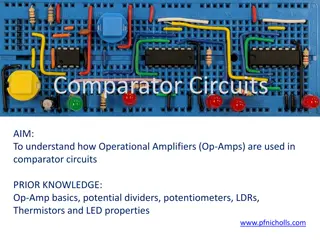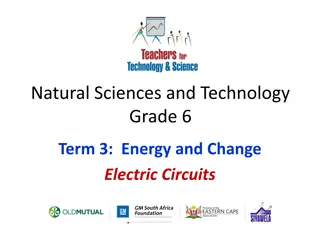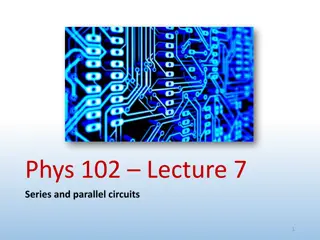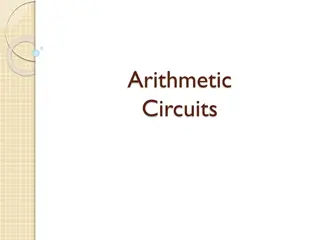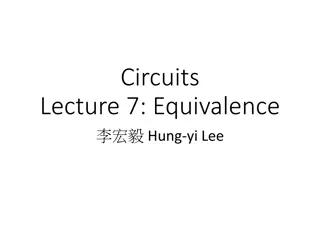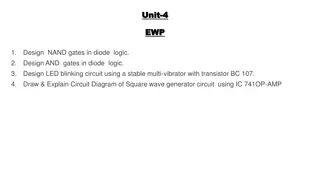Understanding Circuits: Exploring Requirements, Function, and Analogies
Delve into the world of circuits by learning about their requirements, functions, and different types. Discover how circuits work, their components like bulbs and batteries, and explore analogies like comparing circuits to water parks. Gain insights into the flow of electrons and the essential laws governing circuit behavior. Experiment with building circuits to deepen your understanding and sketch your observations.
Download Presentation

Please find below an Image/Link to download the presentation.
The content on the website is provided AS IS for your information and personal use only. It may not be sold, licensed, or shared on other websites without obtaining consent from the author. Download presentation by click this link. If you encounter any issues during the download, it is possible that the publisher has removed the file from their server.
E N D
Presentation Transcript
What do you already know? (electrochemical cell = battery)
Essential Questions for Circuits What are the requirements of a circuit? What is actually going on in a working circuit? What variable(s) affect what other variable(s) in a circuit? What law(s) and formulas govern the relationship(s) between these variables? What are the different kinds of circuits? How do they differ?
Build a circuit with A battery, a bulb, wires Draw it in your notes, ONCE you figure out how to make the light go on.
What is really happening in the circuit? Go onto Phet, Circuit Construction Kit (DC Only) Build a circuit with one bulb, one battery, one switch, and as many wires as you need to make the circuit show you clearly what is happening when the switch is closed. What do the moving balls represent? Which way do they move? Click the circle in front of Schematic. Sketch the circuit in your notes.
What is really happening in the circuit? The balls represent electrons obviously NOT shown to scale. The electrons move from negative on the battery, around to positive. HOWEVER, Current was first defined as the flow of positive charges from the positive terminal to the negative terminal.
A Useful Analogy Sometimes, a closed conducting loop (circuit) is compared to a water (amusement) park. Complete this analogy: Water Park pump Circuit electrons pipes bulb
A Useful Analogy Sometimes, a closed conducting loop (circuit) is compared to a water (amusement) park. Complete this analogy: Water Park pump water pipes slide/obstacles Circuit battery electrons wires bulb
Practice Answer CYU questions 1 & 2 on PCR Lesson 2b. Put the answers in your daily notes.
Electric Current What is it? What are its units? How do we measure it? What variables affect how much current exists in an appliance?
Electric Current The flow rate of charges Unit: ampere (amps, or just A) 1 ampere = 1coulomb of charge flowing thru a conductor in 1 second Measured with an ammeter By convention, the current flows from positive around to negative.
What Variable Affects what other Variable(s) in a Circuit? What is the mathematical relationship between the ______________(_____) through a bulb and the ______________(___) across the bulb in an electrical circuit?
What is the mathematical relationship between the current(amps) thru one bulb and the potential difference(volts) across the bulb? What is the mathematical relationship between the current(amps) thru two bulbs and the potential difference(volts) across the bulbs? Now, do the lab again, this time with a real bulb, using real wires, and a power supply. What is different when you graph your data? Why do you think it is different?
And the lab showed The electrical current (in amps) thru a bulb is directly proportional to the potential difference (in volts) across the bulb. What measurement changed when you added a second bulb, and re-did the experiment?
Resistance What is it? (use The Lazy Mile at the water park) What happens in the circuit as the resistance changes? What is the mathematical relationship between the current(amps) thru a bulb and the resistance(ohms) of the bulb? What are its units? How does the PhET simulation show it?
Ohms Law: I = V/R The current in a circuit element (like a bulb) is directly proportional to the potential difference across the element, and inversely proportional to the resistance of the element
Measurements in a circuit I: Current (in amperes (A)) V: Potential difference (in volts (V)) R: Resistance (in ohms ( )) I = V/R
Example Problem (Ohms Law) Ex: A single loop circuit is made with a 1.5 volt battery, and a light bulb. An ammeter is used to measure a 0.15A current in the loop. What is the resistance of the bulb in this circuit?
Practice Complete the 3 practice problems on the WS Use the PCR if you need extra support. Use the formula (Ohm s Law) as a guide to your thinking for #4. It is taken from the PCR lesson 3c (CYU#6)
Equations I= V/R V = IR R = V/I P = I( V) P=I2R P = ( V)2/R
Example Problem Ex: A single loop circuit is made with a 1.5 volt battery, and a light bulb. An ammeter is used to measure a 0.15A current in the loop. What is the resistance of the bulb in this circuit? What power does the battery supply? What power does the bulb dissipate?
Now Do the Ohms Law lab w/ REAL bulbs What is the mathematical relationship between the current(amps) thru two bulbs and the potential difference(volts) across the bulbs? How do your results differ from those in the simulation? Why do you think this happened? What did you notice about the bulbs as the trials proceeded? Why do you think that happened?
Two Bulb Circuit, cont. Now leave the battery eliminator set at 4.5V. Place the ammeter at different positions in the circuit. What do you notice about the value it measures? (Where is the current greater?) Put the voltmeter across The battery eliminator Bulb 1 Bulb 2 What do you notice?
Series Circuits All elements in a series circuit have the same current If you add up the potential differences in the elements that are in series, the result is equal to the potential difference of the battery. The power supplied by the battery equals the sum of the power dissipated by all resistors. In Series, Req= R1+ R2+ +Rn
Series Circuits Charge is neither created nor destroyed, so the __________ is the same for all parts of the circuit. Energy is neither created nor destroyed, so the sum of the ______________ for all the bulbs must equal the same measurement for the battery.
The brighter the bulb The greater the .
The brighter the bulb The greater the POWER
Example Draw a series circuit with a 3.0V battery, a 6 light bulb, and a 3 light bulb. Determine the equivalent resistance of the circuit, the current through the circuit, the potential difference across each item in the circuit, the power supplied by the battery, and the power dissipated ( used ) by each of the bulbs.
What is a Watt? A) the unit for energy B) the unit for current C) the unit for the rate of energy used D) a measurement of power E) equal to a joule per second F) the amount of energy PECO charges about $0.20 for.
What does the 60 watts mean for a bulb? A) The bulb has 60 W and after that, it is used up B) When turned on, the bulb uses 60 watts regardless of the circuit it is in C) If the bulb is across a potential difference of 120V, the bulb dissipates 60 J of energy each second.
60W vs 120W Determine the resistance of a 60W bulb and of a 120W bulb. (they both plug into a 120V outlet) Which draws more current?
What is a KILOWATT-HOUR? A) a unit of power B) a unit of electricity C) a unit of energy D) a unit of work E) a unit of current F) a unit of potential difference G) the amount of heat needed to warm 1.0 ml of water by 1.0 C H) the amount of heat energy needed to warm 8.6 liters of water by 100 C
What does that 60W bulb cost . for two hours?
Save some $$$ A 7W LED provides the same light output as a 13W CFL and as a conventional (incandescent) 60W bulb. If the lamp you wish to use is on for two hours a day, how much will that bulb cost you in one year? (use $0.20 per kWhr, and assume 120V for the outlet potential difference)
Big Picture cost Incandescent CFL LED Purchase Cost ($) 0.94 1.60 5.00 Power (W) 60 13 7 Life (hrs) 1200 8000 50 000
A kWhr is. (1000W) x (1hr) (1000J/s) x (3600s) 3 600 000J 3.6 x 106J The amount of energy PECO charges about $0.20 for
Parallel Circuits All elements in a parallel circuit have the same potential difference If you add up the current in all the elements that are in parallel, the result is equal to the current through the battery. The power supplied by the battery equals the power dissipated by the resistors in total In Parallel, 1/Req= 1/R1+ 1/R2+ +1/Rn
Electricity Test covers Static Electricity: PCR Lessons 1, 2, 3a Current Electricity: PCR Lessons 2,3,4a&c










